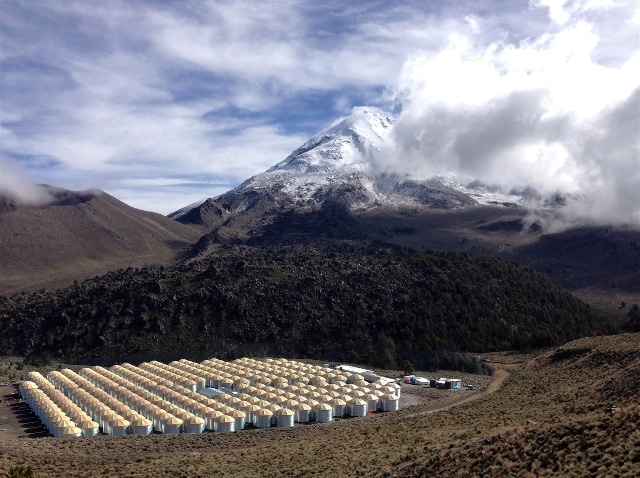Apr 19 2016
Scientists operating the newly commissioned High Altitude Water Cherenkov (HAWC) Observatory today presented the deepest survey map to date of the highest energy gamma ray sources in the northern sky.
 MSU faculty members are playing key roles in the new High-Altitude Water Cherenkov (HAWC) Gamma-Ray Observatory in Puebla, Mexico. (Credit: Michigan State University)
MSU faculty members are playing key roles in the new High-Altitude Water Cherenkov (HAWC) Gamma-Ray Observatory in Puebla, Mexico. (Credit: Michigan State University)
The team, which includes faculty and students from Michigan State University, presented its findings at this week's meeting of the American Physical Society meeting.
The HAWC sky map shows a clear picture of gamma-ray emitting objects in the galactic plane—many undetected by previous searches. HAWC images of some of these sources resolve details of their internal structure, shedding light on the dynamics of ultra-high energy particles in sources such as pulsar wind nebulae and supernova remnants.
Located 13,500 feet above sea level near Puebla, Mexico, HAWC is the newest tool available to visualize these explosive events and learn more about the nature of high-energy radiation, possessing approximately 15 times the sensitivity of previous gamma-ray survey instruments. Completed in March 2015, MSU has played a key role in HAWC from its beginning.
MSU physics and astronomy professors James Linnemann, Kirsten Tollefson and Tyce DeYoung lead a team of postdocs, graduate students and undergraduate students who helped to build the detector and are developing many of the key systems that collect and analyze HAWC data, plus monitor its operations.
“HAWC is starting to see new sources of very high-energy gamma-ray showers that have never been detected before,” said Linnemann, who was the HAWC electronics coordinator during construction. “The HAWC Observatory is showing that it is a much better ‘eye on the sky’ than the predecessor Milagro experiment; HAWC can resolve details which were impossible for Milagro.”
Tollefson, who serves as deputy manager of the HAWC detector, said that the new sky map shows that HAWC is working well.
“HAWC is excited to study these new sources, but the MSU group is using this data to put constraints on dark matter models and searching for evaporating primordial black holes.”
Tollefson added that HAWC is also looking for sources whose brightness is variable.
“Just last week, we notified the astronomy community about an increase in brightness of one of the active galaxies seen in our sky map,” she said. “Studying its time variability allows us to better understand the mechanism by which the black hole at its center accelerates particles to extremely high energies.”
The HAWC team is an international collaboration of approximately 120 scientists from 25 universities and national labs in the United States, Mexico and Europe. HAWC was built with the support of the National Science Foundation, the U.S. Department of Energy and El Consejo Nacional de Ciencia y Tecnologia in Mexico.